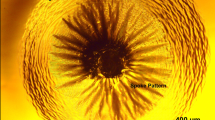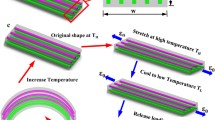Abstract
Morphing is a process that spontaneously creates a three-dimensional (3D) curved surface shape from a two-dimensional flat sheet. It has attracted attention in various applications, ranging from flexible electronics to mechanical metamaterials. Some approaches can realize the morphing of a flat sheet through bending, folding, and buckling. Among these approaches, folding may create more complex 3D structures with a pre-strained shape memory polymer (SMP) sheet than other approaches. However, robust shape control is difficult because localized heating in the active zone when using SMP sheets presents practical challenges. In addition, the folding approach makes the edges sharp and limits the ridge pattern to create a smoothly curved shape. Here, we propose an alternative approach to morph the passive elements in an SMP sheet with two slits that define one active element and two passive elements in the sheet. These elements can buckle when shrinking the active element above the glass transition temperature via light absorption. We predict the curvature of the passive elements as a function of the shrinkage in the active zone and determine an approximate formula to describe the relationship between curvature and shrinkage. We find that the theoretical predictions agree well with the experimental results. Thus, our method could be an alternative approach for morphing techniques exploiting SMP sheets in response to light.





Similar content being viewed by others
References
Gracias, D.H.: Stimuli responsive self-folding using thin polymer films. Curr. Opin. Chem. Eng. 2(1), 112–119 (2013). https://doi.org/10.1016/j.coche.2012.10.003
Liu, Y., Genzer, J., Dickey, M.D.: ”2D or not 2D": shape-programming polymer sheets. Prog. Polym. Sci. 52, 79–106 (2016). https://doi.org/10.1016/j.progpolymsci.2015.09.001
Callens, S.J.P., Zadpoor, A.A.: From flat sheets to curved geometries: origami and kirigami approaches. Mater. Today 21(3), 241–264 (2018). https://doi.org/10.1016/j.mattod.2017.10.004
van Manen, T., Janbaz, S., Zadpoor, A.A.: Programming the shape-shifting of flat soft matter. Mater. Today 21(2), 144–163 (2018). https://doi.org/10.1016/j.mattod.2017.08.026
Holmes, D.P.: Elasticity and stability of shape-shifting structures. Curr. Opin. Colloid Interface Sci. 40(Nature 489 7414 2012), 118–137 (2019). https://doi.org/10.1016/j.cocis.2019.02.008
Thill, C., Etches, J., Bond, I., Potter, K., Weaver, P.: Morphing skins. Aeronaut. J. 112(1129), 117–139 (2008). https://doi.org/10.1017/s0001924000002062
Randall, C.L., Gultepe, E., Gracias, D.H.: Self-folding devices and materials for biomedical applications. Trends Biotechnol. 30(3), 138–146 (2012). https://doi.org/10.1016/j.tibtech.2011.06.013
Tolley, M.T., Felton, S.M., Aukes, D., Rus, D., Wood, R.J.: Self-folding origami: shape memory composites activated by uniform heating. Smart Mater. Struct. 23(9), 094006 (2014). https://doi.org/10.1088/0964-1726/23/9/094006
Gladman, A.S., Matsumoto, E.A., Nuzzo, R.G., Mahadevan, L., Lewis, J.A.: Biomimetic 4D printing. Nat. Mater. 15(4), 413–418 (2016). https://doi.org/10.1038/nmat4544
Gao, B., Yang, Q., Zhao, X., **, G., Ma, Y., Xu, F.: 4D bioprinting for biomedical applications. Trends Biotechnol. 34(9), 746–756 (2016). https://doi.org/10.1016/j.tibtech.2016.03.004
Gracias, D.H., Tien, J., Breen, T.L., Hsu, C., Whitesides, G.M.: Forming electrical networks in three dimensions by self-assembly. Science 289(5482), 1170–1172 (2000). https://doi.org/10.1126/science.289.5482.1170
Rogers, J.A., Huang, Y., Schmidt, O.G., Gracias, D.H.: Origami MEMS and NEMS. MRS Bull. 41(02), 123–129 (2016). https://doi.org/10.1557/mrs.2016.2
McEvoy, M.A., Correll, N.: Materials that couple sensing, actuation, computation, and communication. Science 347(6228), 1261689 (2015). https://doi.org/10.1126/science.1261689
van Rees, W.M., Vouga, E., Mahadevan, L.: Growth patterns for shape-shifting elastic bilayers. Proc. Natl. Acad. Sci. 114(44), 11597–11602 (2017). https://doi.org/10.1073/pnas.1709025114
van Manen, T., Janbaz, S., Zadpoor, A.A.: Programming 2D/3D shape-shifting with hobbyist 3D printers. Mater. Horiz. 4(6), 1064–1069 (2017). https://doi.org/10.1039/C7MH00269F
Erb, R.M., Sander, J.S., Grisch, R., Studart, A.R.: Self-sha** composites with programmable bioinspired microstructures. Nat. Commun. 4(1), 1712 (2013). https://doi.org/10.1038/ncomms2666
White, T.J., Broer, D.J.: Programmable and adaptive mechanics with liquid crystal polymer networks and elastomers. Nat. Publ. Group 14(11), 1087–1098 (2015). https://doi.org/10.1038/nmat4433
Kotikian, A., Truby, R.L., Boley, J.W., White, T.J., Lewis, J.A.: 3D printing of liquid crystal elastomeric actuators with spatially programed nematic order. Adv. Mater. 30(10), 1706164 (2018). https://doi.org/10.1002/adma.201706164
Kotikian, A., McMahan, C., Davidson, E.C., Muhammad, J.M., Weeks, R.D., Daraio, C., Lewis, J.A.: Untethered soft robotic matter with passive control of shape morphing and propulsion. Sci. Robot. 4(33), 7044 (2019). https://doi.org/10.1126/scirobotics.aax7044
Ford, M.J., Ambulo, C.P., Kent, T.A., Markvicka, E.J., Pan, C., Malen, J., Ware, T.H., Majidi, C.: A multifunctional shape-morphing elastomer with liquid metal inclusions. Proc. Natl. Acad. Sci. 116(43), 21438–21444 (2019). https://doi.org/10.1073/pnas.1911021116
**ao, Y.-Y., Jiang, Z.-C., Tong, X., Zhao, Y.: Biomimetic locomotion of electrically powered “Janus’’ soft robots using a liquid crystal polymer. Adv. Mater. 31(36), 1903452 (2019). https://doi.org/10.1002/adma.201903452
Wu, J., Yuan, C., Ding, Z., Isakov, M., Mao, Y., Wang, T., Dunn, M.L., Qi, H.J.: Multi-shape active composites by 3D printing of digital shape memory polymers. Sci. Rep. 6(1), 24224 (2016). https://doi.org/10.1038/srep24224
Mao, Y., Ding, Z., Yuan, C., Ai, S., Isakov, M., Wu, J., Wang, T., Dunn, M.L., Qi, H.J.: 3D printed reversible shape changing components with stimuli responsive materials. Sci. Rep. 6(1), 24761 (2016). https://doi.org/10.1038/srep24761
Peraza-Hernandez, E.A., Hartl, D.J., Malak, R.J., Jr., Lagoudas, D.C.: Origami-inspired active structures: a synthesis and review. Smart Mater. Struct. 23(9), 094001 (2014). https://doi.org/10.1088/0964-1726/23/9/094001
Lauff, C., Simpson, T.W., Frecker, M., Ounaies, Z., Ahmed, S., von Lockette, P., Strzelec, R., Sheridan, R., Lien, J.-M.: Differentiating bending from folding in origami engineering using active materials. In: ASME 2014 International Design Engineering Technical Conferences and Computers and Information in Engineering Conference, 05–080400508040 (2014). https://doi.org/10.1115/detc2014-34702
Liu, Y., Liu, Y., Boyles, J.K., Genzer, J., Dickey, M.D.: Self-folding of polymer sheets using local light absorption. Soft Matter 8(6), 1764–1769 (2012). https://doi.org/10.1039/c1sm06564e
Liu, Y., Mailen, R., Zhu, Y., Dickey, M.D., Genzer, J.: Simple geometric model to describe self-folding of polymer sheets. Phys. Rev. E 89(4), 042601–8 (2014). https://doi.org/10.1103/physreve.89.042601
Na, J.-H., Na, J.-H., Evans, A.A., Evans, A.A., Bae, J., Bae, J., Chiappelli, M.C., Chiappelli, M.C., Santangelo, C.D., Lang, R.J., Lang, R.J., Hull, T.C., Hull, T.C., Hayward, R.C.: Programming reversibly self-folding origami with micropatterned photo-crosslinkable polymer trilayers. Adv. Mater. 27(1), 79–85 (2014). https://doi.org/10.1002/adma.201403510
Mailen, R.W., Liu, Y., Dickey, M.D., Zikry, M., Genzer, J.: Modelling of shape memory polymer sheets that self-fold in response to localized heating. Soft Matter 11(39), 7827–7834 (2015). https://doi.org/10.1039/c5sm01681a
Davis, D., Mailen, R., Genzer, J., Dickey, M.D.: Self-folding of polymer sheets using microwaves and graphene ink. RSC Adv. 5(108), 89254–89261 (2015). https://doi.org/10.1039/c5ra16431a
Hubbard, A.M., Mailen, R.W., Zikry, M.A., Dickey, M.D.: Controllable curvature from planar polymer sheets in response to light. Soft Matter 13(12), 2299–2308 (2017). https://doi.org/10.1039/c7sm00088j
Rus, D., Tolley, M.T.: Design, fabrication and control of origami robots. Nat. Rev. Mater. (2018). https://doi.org/10.1038/s41578-018-0009-8
Felton, S.M., Tolley, M.T., Shin, B., Onal, C.D., Demaine, E.D., Rus, D., Wood, R.J.: Self-folding with shape memory composites. Soft Matter 9(32), 7688–8 (2013). https://doi.org/10.1039/c3sm51003d
Felton, S., Tolley, M., Demaine, E., Rus, D., Wood, R.: A method for building self-folding machines. Science 345(6197), 644–646 (2014). https://doi.org/10.1126/science.1252610
Timoshenko, S., Gere, J.M.: Theory of Elastic Stability, 2nd edn. Dover Publications, Mineola (1961)
Mikata, Y.: Complete solution of elastica for a clamped-hinged beam, and its applications to a carbon nanotube. Acta Mech. 190(1–4), 133–150 (2007). https://doi.org/10.1007/s00707-006-0402-z
Bigoni, D., Bosi, F., Misseroni, D., Dal Corso, F., Noselli, G.: New phenomena in nonlinear elastic structures: from tensile buckling to configurational forces. In: Bigoni, D. (ed.) Extremely Deformable Structures, pp. 55–135. Springer, Vienna (2015). https://doi.org/10.1007/978-3-7091-1877-1_2
Wagner, T.J.W., Vella, D.: The ‘sticky elastica’: delamination blisters beyond small deformations. Soft Matter 9(4), 1025–1030 (2013). https://doi.org/10.1039/c2sm26916c
Wilt, J.K., Yang, C., Gu, G.X.: Accelerating auxetic metamaterial design with deep learning. Adv. Eng. Mater. 22(5), 1901266 (2020). https://doi.org/10.1002/adem.201901266
Mao, Y., He, Q., Zhao, X.: Designing complex architectured materials with generative adversarial networks. Sci. Adv. 6(17), 4169 (2020). https://doi.org/10.1126/sciadv.aaz4169
Hanakata, P.Z., Cubuk, E.D., Campbell, D.K., Park, H.S.: Accelerated search and design of stretchable graphene Kirigami using machine learning. Phys. Rev. Lett. 121(25), 255304 (2018). https://doi.org/10.1103/PhysRevLett.121.255304
Hanakata, P.Z., Cubuk, E.D., Campbell, D.K., Park, H.S.: Forward and inverse design of Kirigami via supervised autoencoder. Phys. Rev. Res. 2(4), 042006 (2020). https://doi.org/10.1103/PhysRevResearch.2.042006
Forte, A.E., Hanakata, P.Z., **, L., Zari, E., Zareei, A., Fernandes, M.C., Sumner, L., Alvarez, J., Bertoldi, K.: Inverse design of inflatable soft membranes through machine learning. Adv. Func. Mater. 32(16), 2111610 (2022). https://doi.org/10.1002/adfm.202111610
Acknowledgements
This work was supported by JSPS KAKENHI Grant Number JP18K03838.
Author information
Authors and Affiliations
Corresponding author
Additional information
Publisher's Note
Springer Nature remains neutral with regard to jurisdictional claims in published maps and institutional affiliations.
Rights and permissions
Springer Nature or its licensor (e.g. a society or other partner) holds exclusive rights to this article under a publishing agreement with the author(s) or other rightsholder(s); author self-archiving of the accepted manuscript version of this article is solely governed by the terms of such publishing agreement and applicable law.
About this article
Cite this article
Morimoto, T., Ashida, F., Inoue, N. et al. Curvature arising in shape memory polymer sheets via light absorption. Acta Mech 233, 5403–5413 (2022). https://doi.org/10.1007/s00707-022-03400-6
Received:
Revised:
Accepted:
Published:
Issue Date:
DOI: https://doi.org/10.1007/s00707-022-03400-6




